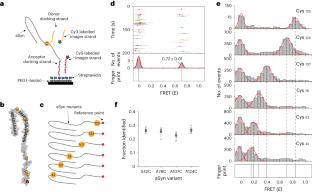2024-02-13 オランダ・デルフト工科大学(TUDelft)
<関連情報>
- https://www.tudelft.nl/en/2024/tnw/scientists-develop-new-technology-to-identify-individual-full-length-human-proteins
- https://www.nature.com/articles/s41565-023-01598-7
全長1分子タンパク質フィンガープリンティング Full-length single-molecule protein fingerprinting
Mike Filius,Raman van Wee,Carlos de Lannoy,Ilja Westerlaken,Zeshi Li,Sung Hyun Kim,Cecilia de Agrela Pinto,Yunfei Wu,Geert-Jan Boons,Martin Pabst,Dick de Ridder & Chirlmin Joo
Nature Nanotechnology Published:13 February 2024
DOI:https://doi.org/10.1038/s41565-023-01598-7

Abstract
Proteins are the primary functional actors of the cell. While proteoform diversity is known to be highly biologically relevant, current protein analysis methods are of limited use for distinguishing proteoforms. Mass spectrometric methods, in particular, often provide only ambiguous information on post-translational modification sites, and sequences of co-existing modifications may not be resolved. Here we demonstrate fluorescence resonance energy transfer (FRET)-based single-molecule protein fingerprinting to map the location of individual amino acids and post-translational modifications within single full-length protein molecules. Our data show that both intrinsically disordered proteins and folded globular proteins can be fingerprinted with a subnanometer resolution, achieved by probing the amino acids one by one using single-molecule FRET via DNA exchange. This capability was demonstrated through the analysis of alpha-synuclein, an intrinsically disordered protein, by accurately quantifying isoforms in mixtures using a machine learning classifier, and by determining the locations of two O-GlcNAc moieties. Furthermore, we demonstrate fingerprinting of the globular proteins Bcl-2-like protein 1, procalcitonin and S100A9. We anticipate that our ability to perform proteoform identification with the ultimate sensitivity may unlock exciting new venues in proteomics research and biomarker-based diagnosis.


